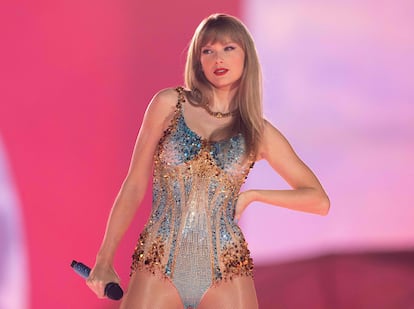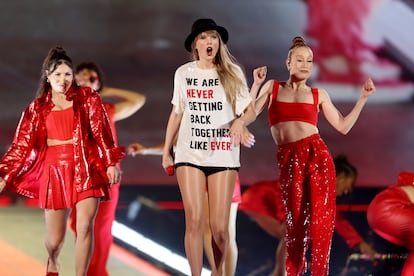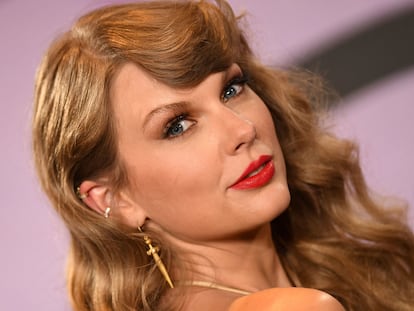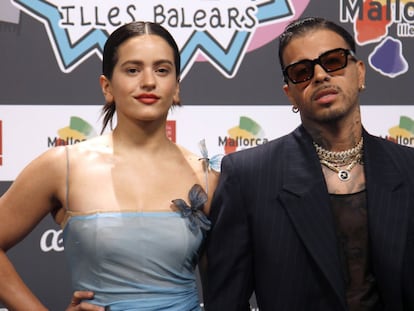How Taylor Swift turned her career into a money-making machine
The artist, whose fortune is estimated at $570 million, will end 2023 among the exclusive club of billionaires thanks to earnings from her ongoing tour

The last time Taylor Swift performed in Spain was on March 19, 2011, at Madrid’s Palacio de Deportes, during the singer’s Speak Now World Tour. Despite the fact that she had already won several Grammys — among them, Album of the Year for Fearless, her second record, released in 2008 — only 4,000 attended the show, far below the venue’s capacity of 15,500. The rest of her concerts in Europe followed the same pattern.
At that time, she was considered an inoffensive country singer, a product for tweens yearning for their Prince Charming. Few considered her a serious artist. Proof of that came at 2009′s MTV Video Music Awards, the night Kanye West burst onstage to insist that the title of Best Female Video should go to Beyonce for “Single Ladies” and not Swift for “You Belong With Me.” Some defended the rapper’s words, though not his choice of messaging. Much has changed since then.
As Shania Twain did in the mid-1990s, Swift decided to move away from her country roots to embrace mainstream pop. She made her first foray into the genre with her 2012 album Red, which featured the work of all-powerful Swedish producer Max Martin — the mind behind hits like Britney Spears’ “…Baby One More Time” and Katy Perry’s “I Kissed A Girl.” Her reinvention was successful. She perfected her new image two years later with the album 1989. It won Album of the Year at the Grammys in 2016, and it remains her best-selling record, with more than 10 million copies sold.

Swift proved she was here to stay. Her tenth studio album, Midnights, broke several records. It became the most-listened record in history on Spotify on its release date, with 184.6 million plays in just 24 hours. In the United States, over 1.5 million copies were sold in a week, and its songs swept the Billboard Hot 100′s top 10. Swift’s albums also accounted for one of every 25 vinyls sold in the U.S. in 2022: Midnights topped the list with 1.7 million copies, and Folklore, originally released in 2020, took seventh place with 174,000. The streaming era may have ended the days of astronomic sales figures, but her numbers come close to those of pop artists at the end of the last century.
Meanwhile, a recent poll by Morning Consult revealed an interesting fact: 53% of American adults consider themselves fans of the singer, while 16% call themselves avid fans. “The Swift fandom, which outnumbers that of other pop stars like Beyoncé, Miley Cyrus and Harry Styles, is largely made up of millennials, and leans white, suburban and Democratic,” the study says. Unsurprisingly, the release of tickets for her current tour, caused the collapse of Ticketmaster after receiving over 3.5 million requests, many of them from bots.
Since it kicked off on March 17 at Glendale’s State Farm Stadium, Swift’s Eras Tour has made headlines for its spectacular production and the 44 songs it includes in just over three hours. With 52 dates across the United States, like the 2018 Reputation Tour, it takes place exclusively in arenas. By the time it ends on August 9, in Inglewood, California, Swift will have made yet another fortune.
Billboard predicts the tour will gross $591 million, while Forbes estimates earnings at $620 million. Regardless of the precise figure, it will be the most lucrative solo artist tour in history: it will surpass the nearly $408 million that Madonna’s Sticky & Sweet Tour made in 2008 and 2009. Bearing in mind that Forbes estimated that her fortune was $570 million in 2022, Swift will end the year entering the exclusive billionaires club.
Pop stars who reach that tier tend to owe their fortunes to business deals. Rihanna, for example, reached a net worth $1.7 billion in 2021 thanks to the Fenty Beauty makeup line and Savage X Fenty lingerie brand. But Swift has built an empire on her songs alone, from record sales, streaming royalties — she has 84 million monthly listeners on Spotify — and the tickets that sell out in a matter of minutes. Swift has partnered with brands in the past. She collaborated on a fashion collection with Stella McCartney in 2019. And in 2021, coinciding with the launch of Red (Taylor’s version), she teamed up with Starbucks — for a limited time anyone could order a Taylor’s Latte — and the online fitness company Peloton. But unlike Rihanna or Beyoncé, who recently parted ways with Adidas due to the low turnover of her Ivy Park line, Swift doesn’t have any brands of her own. She doesn’t need them.
Sign up for our weekly newsletter to get more English-language news coverage from EL PAÍS USA Edition
Tu suscripción se está usando en otro dispositivo
¿Quieres añadir otro usuario a tu suscripción?
Si continúas leyendo en este dispositivo, no se podrá leer en el otro.
FlechaTu suscripción se está usando en otro dispositivo y solo puedes acceder a EL PAÍS desde un dispositivo a la vez.
Si quieres compartir tu cuenta, cambia tu suscripción a la modalidad Premium, así podrás añadir otro usuario. Cada uno accederá con su propia cuenta de email, lo que os permitirá personalizar vuestra experiencia en EL PAÍS.
¿Tienes una suscripción de empresa? Accede aquí para contratar más cuentas.
En el caso de no saber quién está usando tu cuenta, te recomendamos cambiar tu contraseña aquí.
Si decides continuar compartiendo tu cuenta, este mensaje se mostrará en tu dispositivo y en el de la otra persona que está usando tu cuenta de forma indefinida, afectando a tu experiencia de lectura. Puedes consultar aquí los términos y condiciones de la suscripción digital.
More information
Archived In
Últimas noticias
Raúl Rocha, from jet-setting with Miss Universe to arms trafficking and fuel theft
80,000 barrels of Mexican oil sent to Cuba: Havana drawn into the US–Mexico clash
Human rights activists, opposition members, and a minor: Maduro’s other political prisoners
Israel sparks a civil war within the MAGA movement
Most viewed
- Reinhard Genzel, Nobel laureate in physics: ‘One-minute videos will never give you the truth’
- Pablo Escobar’s hippos: A serious environmental problem, 40 years on
- Charles Dubouloz, mountaineering star, retires at 36 with a farewell tour inspired by Walter Bonatti
- Why we lost the habit of sleeping in two segments and how that changed our sense of time
- The fall of a prolific science journal exposes the billion-dollar profits of scientific publishing











































